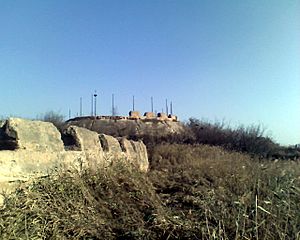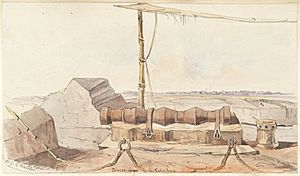Battle of Taku Forts (1859) facts for kids
Quick facts for kids Second Battle of Taku Forts |
|||||||
|---|---|---|---|---|---|---|---|
| Part of the Second Opium War | |||||||
 The Taku Forts |
|||||||
|
|||||||
| Belligerents | |||||||
| Commanders and leaders | |||||||
| Strength | |||||||
| Britain: 1,160 (on land) 11 gunboats 4 steam ships |
4,000 60 guns 6 forts |
||||||
| Casualties and losses | |||||||
| Britain: 3 gunboats sunk 3 gunboats grounded 81 killed 345 wounded France: 12 killed 23 wounded United States: 1 killed 1 wounded 1 launch damaged |
32 killed or wounded | ||||||
The Second Battle of Taku Forts was a fight that happened in June 1859. It was part of the Second Opium War in China. British and French forces tried to capture the Taku Forts near the Hai River. But they failed, and the Chinese won this battle. An American ship also helped the British and French during the fight.
Contents
Preparing for Battle: The Taku Forts
After an earlier battle in 1858, the Chinese Emperor Xianfeng put a general named Sengge Rinchen in charge. Sengge Rinchen was a Mongol general. His job was to make sure China's coast was safe from attacks. He worked very hard to fix and improve the defenses. He knew the British would likely return.
The general built a second, stronger barrier across the river. This barrier was made of large tree trunks linked with heavy chains. It was meant to stop British ships. He also dug two rows of ditches in front of the forts. These ditches were filled with water and mud. Behind them, he placed sharp iron spikes. Sengge Rinchen also made sure his soldiers were well-trained. They learned how to use their cannons to fight off the British ships.
The Battle Begins: June 25, 1859
On the morning of June 25, 1859, the British saw that the Chinese forts looked stronger. But they didn't see many soldiers or battle flags. This made them think the forts were not well-guarded. Local people also told them that only a few soldiers were there. The British even cut through the first river barrier without any trouble.
Then, the British tried to break the second barrier with their admiral's ship, the Plover. They had done this successfully before. But this time, the strong barrier stopped the ship. As the British ships slowed down, the Chinese removed covers from their gun holes. Suddenly, the forts opened fire with their cannons.
An American officer, Josiah Tattnall, said: "On the Admiral’s reaching the first barrier the forts suddenly swarmed with men, and a terrible fire from very heavy guns was opened... from all the forts."
The first cannon shot hit the Plover and killed its bow gunner. The ship was badly damaged and sank into the mud. Most of its crew died. Other British ships were also hit hard. Two ships got stuck in the mud, and two others sank. The remaining ships tried to get away. Chinese smaller guns kept firing, hitting officers and soldiers on shore.
As evening came, the Chinese guns fired less often. The British decided to send their soldiers to attack the forts on land. The river's strong current made it hard for their boats to move. An American ship, the Toey-Wan, was nearby. Its commander, Josiah Tattnall III, decided to help. He towed several British boats full of soldiers up the river. This help was against the rules, as the United States was supposed to be neutral.
The landing was delayed, so the British soldiers landed at low tide. They were hundreds of meters from the fort walls. The soldiers slipped and got stuck in the muddy riverbanks. Chinese gunners easily shot them. Those who reached the trenches found them full of mud and water. It was too thick to swim and too thin to walk. Their ammunition got wet, and they were still easy targets. As night fell, some soldiers reached the fort walls. But they were trapped. Chinese defenders dangled bright fireworks over the walls. This lit up the British soldiers for Chinese archers to shoot.
One boat tried to rescue some wounded soldiers. But a cannon shot hit it. The boat broke in half and sank, and everyone on board drowned. By the next morning, over 400 British soldiers were dead or wounded. This included many officers. The Chinese had very few casualties.
After the Battle: A Chinese Victory
This battle was a big defeat for the British. An American interpreter, Samuel Wells Williams, said it was one of the worst defeats the British had faced in a long time. One British survivor said he would rather go through the terrible Charge of the Light Brigade three times than fight at Taku Forts again.
General Sengge Rinchen was very happy with his victory. He wrote to the Emperor that the British might come back. But he believed that one or two more victories would make them lose their confidence.
The Emperor was still careful. He thought the foreigners might be hiding nearby. He worried they would wait for more ships and soldiers to launch a surprise attack.
This battle was a big loss for the British. It forced them to gather a much larger army of 18,000 troops. These troops fought in the Third Battle of Taku Forts later. The battle also delayed the British attack for 13 months. This made the war last another year.
Images for kids






